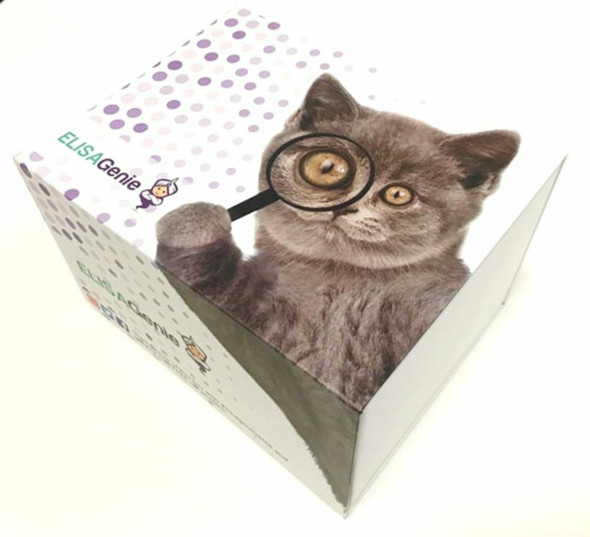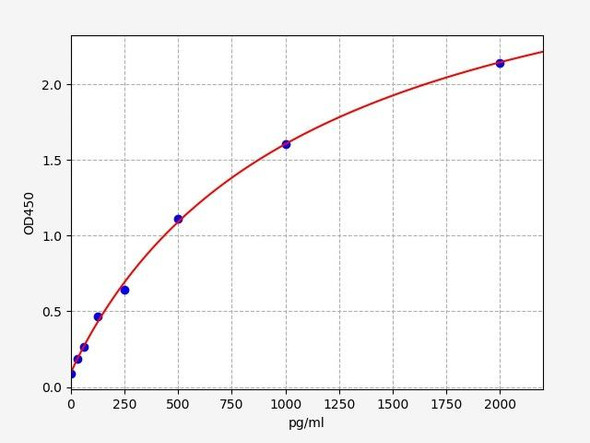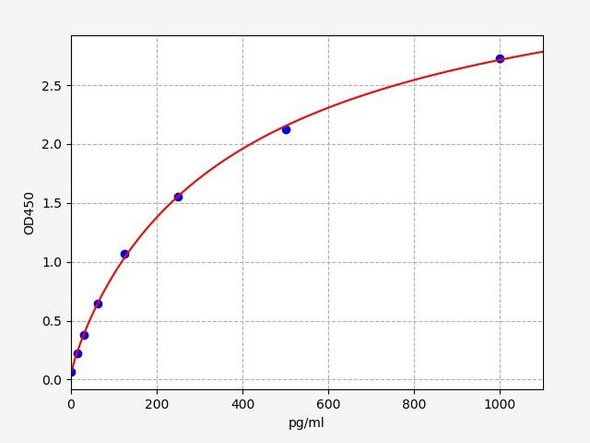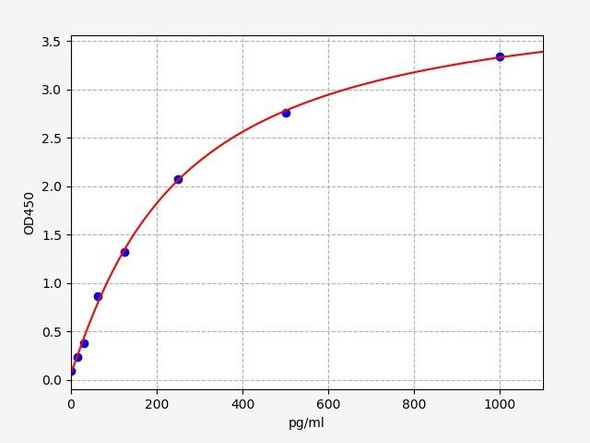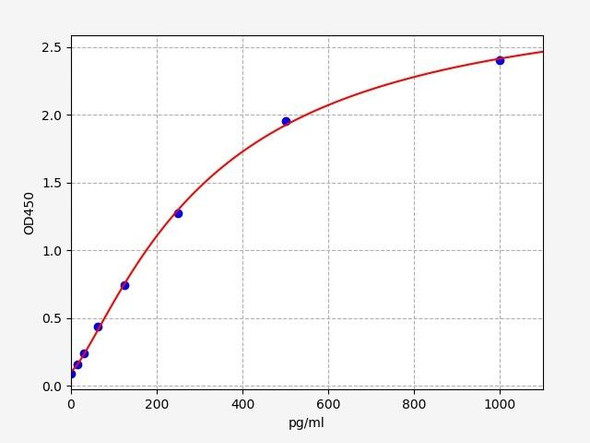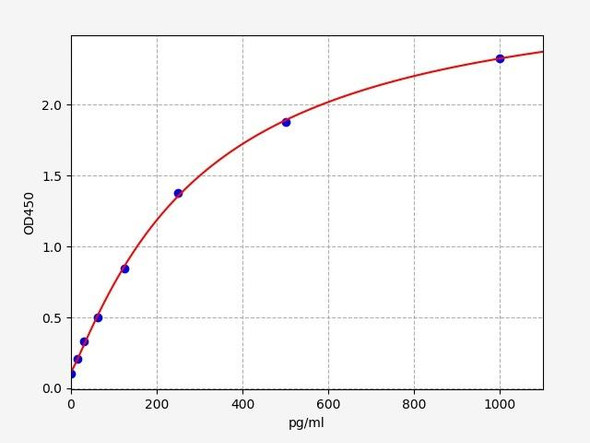Description
Mouse IL-27 ELISA Kit
The Mouse IL27 ELISA Kit is specifically designed for the precise measurement of interleukin 27 (IL-27) levels in mouse serum, plasma, and tissue culture supernatants. This kit offers unparalleled sensitivity and specificity, guaranteeing accurate and consistent results for a variety of research purposes.IL-27 is a key cytokine that plays a vital role in regulating immune responses, inflammation, and autoimmune diseases. It acts as a mediator in both innate and adaptive immunity, making it an important target for studying immune disorders and developing therapeutic interventions.
With its high-quality components and user-friendly protocol, the Mouse IL27 ELISA Kit is a valuable tool for researchers aiming to dissect the intricate mechanisms of immune regulation and inflammatory processes in mouse models. Trust in this kit for robust and reliable data that will propel your research forward.
| Assay type: | Sandwich |
| Format: | 96T |
| Assay time: | 4.5h |
| Reactivity: | Mouse |
| Detection Method: | Colormetric |
| Detection Range: | 31.25-2000 pg/mL |
| Sensitivity: | 18.75 pg/mL |
| Sample Volume Required Per Well: | 100µL |
| Sample Type: | Serum, plasma and other biological fluids |
| Specificity: | This kit recognizes Mouse IL27 ELISA Kit in samples. No significant cross-reactivity or interference between Mouse IL27 ELISA Kit and analogues was observed. |
This ELISA kit uses Sandwich-ELISA as the method. The micro ELISA plate provided in this kit has been pre-coated with an antibody specific to Mouse IL27. Standards or samples are added to the appropriate micro ELISA plate wells and combined with the specific antibody. Then a biotinylated detection antibody specific for Mouse IL27 and Avidin-Horseradish Peroxidase (HRP) conjugate are added to each micro plate well successively and incubated. Free components are washed away. The substrate solution is added to each well. Only those wells that contain Mouse IL27, biotinylated detection antibody and Avidin-HRP conjugate will appear blue in color. The enzyme-substrate reaction is terminated by adding Stop Solution and the color turns yellow. The optical density (OD) is measured spectrophotometrically at a wavelength of 450 nm ± 2 nm. The OD value is proportional to the concentration of Mouse IL27. The concentration of Mouse IL27 in samples can be calculated by comparing the OD of the samples to the standard curve.
| UniProt Protein Function: | IL27-alpha: Cytokine with pro- and anti-inflammatory properties, that can regulate T-helper cell development, suppress T-cell proliferation, stimulate cytotoxic T-cell activity, induce isotype switching in B-cells, and that has diverse effects on innate immune cells. Among its target cells are CD4 T-helper cells which can differentiate in type 1 effector cells (TH1), type 2 effector cells (TH2) and IL17 producing helper T-cells (TH17). It drives rapid clonal expansion of naive but not memory CD4 T-cells. It also strongly synergizes with IL-12 to trigger interferon- gamma/IFN-gamma production of naive CD4 T-cells, binds to the cytokine receptor WSX-1/TCCR which appears to be required but not sufficient for IL-27-mediated signal transduction. IL-27 potentiate the early phase of TH1 response and suppress TH2 and TH17 differentiation. It induces the differentiation of TH1 cells via two distinct pathways, p38 MAPK/TBX21- and ICAM1/ITGAL/ERK- dependent pathways. It also induces STAT1, STAT3, STAT4 and STAT5 phosphorylation and activates TBX21/T-Bet via STAT1 with resulting IL12RB2 up-regulation, an event crucial to TH1 cell commitment. It suppresses the expression of GATA3, the inhibitor TH1 cells development. In CD8 T-cells, it activates STATs as well as GZMB. IL-27 reveals to be a potent inhibitor of TH17 cell development and of IL-17 production. Indeed IL-27 subunit p28 alone is also able to inhibit the production of IL17 by CD4 and CD8 T-cells. While IL-27 suppressed the development of proinflammatory Th17 cells via STAT1, it inhibits the development of anti-inflammatory inducible regulatory T-cells, iTreg, independently of STAT1. IL-27 has also an effect on cytokine production, it suppresses proinflammatory cytokine production such as IL2, IL4, IL5 and IL6 and activates suppressors of cytokine signaling such as SOCS1 and SOCS3. Apart from suppression of cytokine production, IL-27 also antagonizes the effects of some cytokines such as IL6 through direct effects on T-cells. Another important role of IL-27 is its antitumor activity as well as its antiangiogenic activity with activation of production of antiangiogenic chemokines such as IP- 10/CXCL10 and MIG/CXCL9. In vein endothelial cells, it induces IRF1/interferon regulatory factor 1 and increase the expression of MHC class II transactivator/CIITA with resulting up-regulation of major histocompatibility complex class II. IL-27 also demonstrates antiviral activity with inhibitory properties on HIV-1 replivation. Belongs to the IL-6 superfamily. |
| UniProt Protein Details: | Protein type:Cytokine; Secreted, signal peptide; Secreted Cellular Component: extracellular space; extracellular region Molecular Function:protein binding; interleukin-27 receptor binding; cytokine activity; receptor binding Biological Process: regulation of T-helper 1 cell differentiation; immune system process; regulation of T cell proliferation; innate immune response; inflammatory response; positive regulation of interferon-gamma biosynthetic process |
| UniProt Code: | Q8K3I6 |
| NCBI GenInfo Identifier: | 81866680 |
| NCBI Gene ID: | 246779 |
| NCBI Accession: | Q8K3I6. 1 |
| UniProt Related Accession: | Q8K3I6 |
| Molecular Weight: | 26,542 Da |
| NCBI Full Name: | Interleukin-27 subunit alpha |
| NCBI Synonym Full Names: | interleukin 27 |
| NCBI Official Symbol: | Il27 |
| NCBI Official Synonym Symbols: | p28; Il30; IL-27; IL-27p28 |
| NCBI Protein Information: | interleukin-27 subunit alpha; IL27-A; IL-27-A; interleukin 30; IL-27 p28 subunit; IL-27 subunit alpha |
| UniProt Protein Name: | Interleukin-27 subunit alpha |
| UniProt Synonym Protein Names: | p28 |
| Protein Family: | Interleukin |
| UniProt Gene Name: | Il27 |
| UniProt Entry Name: | IL27A_MOUSE |
As the OD values of the standard curve may vary according to the conditions of the actual assay performance (e. g. operator, pipetting technique, washing technique or temperature effects), the operator should establish a standard curve for each test. Typical standard curve and data is provided below for reference only.
| Concentration (pg/mL) | O.D | Average | Corrected |
| 2000 | 2.371 2.407 | 2.389 | 2.316 |
| 1000 | 1.705 1.731 | 1.718 | 1.645 |
| 500 | 0.991 0.973 | 0.982 | 0.909 |
| 250 | 0.457 0.481 | 0.469 | 0.396 |
| 125 | 0.25 0.25 | 0.25 | 0.177 |
| 62.5 | 0.187 0.161 | 0.174 | 0.101 |
| 31.25 | 0.123 0.127 | 0.125 | 0.052 |
| 0 | 0.066 0.08 | 0.073 | -- |
Precision
Intra-assay Precision (Precision within an assay): 3 samples with low, mid range and high level Mouse IL27 ELISA Kit were tested 20 times on one plate, respectively.
Inter-assay Precision (Precision between assays): 3 samples with low, mid range and high level Mouse IL27 ELISA Kit were tested on 3 different plates, 20 replicates in each plate.
| Intra-assay Precision | Inter-assay Precision | |||||
| Sample | 1 | 2 | 3 | 1 | 2 | 3 |
| n | 20 | 20 | 20 | 20 | 20 | 20 |
| Mean (pg/mL) | 101.85 | 275.54 | 832.19 | 104.81 | 293.53 | 873.27 |
| Standard deviation | 6.02 | 14.69 | 29.38 | 6.48 | 17.52 | 30.30 |
| C V (%) | 5.91 | 5.33 | 3.53 | 6.18 | 5.97 | 3.47 |
Recovery
The recovery of Mouse IL27 ELISA Kit spiked at three different levels in samples throughout the range of the assay was evaluated in various matrices.
| Sample Type | Range (%) | Average Recovery (%) |
| Serum (n=5) | 93-105 | 99 |
| EDTA plasma (n=5) | 92-103 | 98 |
| Cell culture media (n=5) | 90-106 | 97 |
Linearity
Samples were spiked with high concentrations of Mouse IL27 ELISA Kit and diluted with Reference Standard & Sample Diluent to produce samples with values within the range of the assay.
| Serum (n=5) | EDTA plasma (n=5) | Cell culture media (n=5) | ||
| 1:2 | Range (%) | 99-112 | 96-110 | 87-100 |
| Average (%) | 104 | 104 | 92 | |
| 1:4 | Range (%) | 89-101 | 87-101 | 81-93 |
| Average (%) | 96 | 93 | 88 | |
| 1:8 | Range (%) | 89-103 | 83-97 | 88-100 |
| Average (%) | 96 | 90 | 95 | |
| 1:16 | Range (%) | 93-109 | 83-93 | 88-101 |
| Average (%) | 100 | 88 | 93 |
An unopened kit can be stored at 4°C for 1 month. If the kit is not used within 1 month, store the items separately according to the following conditions once the kit is received.
| Item | Specifications | Storage |
| Micro ELISA Plate(Dismountable) | 8 wells ×12 strips | -20°C, 6 months |
| Reference Standard | 2 vials | |
| Concentrated Biotinylated Detection Ab (100×) | 1 vial, 120 µL | |
| Concentrated HRP Conjugate (100×) | 1 vial, 120 µL | -20°C(shading light), 6 months |
| Reference Standard & Sample Diluent | 1 vial, 20 mL | 4°C, 6 months |
| Biotinylated Detection Ab Diluent | 1 vial, 14 mL | |
| HRP Conjugate Diluent | 1 vial, 14 mL | |
| Concentrated Wash Buffer (25×) | 1 vial, 30 mL | |
| Substrate Reagent | 1 vial, 10 mL | 4°C(shading light) |
| Stop Solution | 1 vial, 10 mL | 4°C |
| Plate Sealer | 5 pieces | |
| Product Description | 1 copy | |
| Certificate of Analysis | 1 copy |
- Set standard, test sample and control (zero) wells on the pre-coated plate and record theirpositions. It is recommended to measure each standard and sample in duplicate. Note: addall solutions to the bottom of the plate wells while avoiding contact with the well walls. Ensuresolutions do not foam when adding to the wells.
- Aliquot 100µl of standard solutions into the standard wells.
- Add 100µl of Sample / Standard dilution buffer into the control (zero) well.
- Add 100µl of properly diluted sample (serum, plasma, tissue homogenates and otherbiological fluids) into test sample wells.
- Cover the plate with the sealer provided in the kit and incubate for 90 min at 37°C.
- Aspirate the liquid from each well, do not wash. Immediately add 100µL of BiotinylatedDetection Ab working solution to each well. Cover the plate with a plate seal and gently mix. Incubate for 1 hour at 37°C.
- Aspirate or decant the solution from the plate and add 350µL of wash buffer to each welland incubate for 1-2 minutes at room temperature. Aspirate the solution from each well andclap the plate on absorbent filter paper to dry. Repeat this process 3 times. Note: a microplatewasher can be used in this step and other wash steps.
- Add 100µL of HRP Conjugate working solution to each well. Cover with a plate seal andincubate for 30 min at 37°C.
- Aspirate or decant the solution from each well. Repeat the wash process for five times asconducted in step 7.
- Add 90µL of Substrate Reagent to each well. Cover with a new plate seal and incubate forapproximately 15 min at 37°C. Protect the plate from light. Note: the reaction time can beshortened or extended according to the actual color change, but not by more than 30min.
- Add 50 µL of Stop Solution to each well. Note: Adding the stop solution should be done inthe same order as the substrate solution.
- Determine the optical density (OD value) of each well immediately with a microplate readerset at 450 nm.


